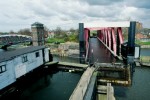|
The Bridgewater Canal The Bridgewater Canal was a unique development as it was the first arterial canal. This means that instead of running parallel to the banks of a river (lateral canal) it crosses valleys by using features such as tunnels, cuttings, embankments and aqueducts. This was not Brindley's first canal as he had been working on the Trent and Mersey Canal, but it was the first of his to be constructed (work on the Trent and Mersey canal didn't commence until 1766). The Duke of Bridgewater (Francis Egerton) owned several coal mines in Worsley but these could not reach there full potential of generating high profits due to the high costs of transporting the coal by horse and cart. The Duke therefore decided to build a canal directly from Worsley to Manchester. Although an act had been obtained to build a canal from Worsley to the Mersey and Irwell navigation as early on as 1737, nothing had actually been done on it. It also appears that a survey had never been carried out, and so it was at this point that the Duke invited Brindley onto the project. Brindley accepted and spent six days from the 1st July 1759 working at Worsley on the survey of the Worsley to Manchester section. He considered the Duke's idea to terminate the canal at Salford, but then proposed a great improvement. Brindley suggested that the canal go from Worsley to Stretford joining there with one of his proposed canals, which he was in the process of designing, running from Manchester to the Grand Trunk (better known as the Trent and Mersey). This would make the full connection from Worsley to Manchester but would more importantly connect Manchester with everywhere else, Liverpool, London, Birmingham, and all of the other places that radiate from the Grand Trunk. Brindley had envisaged this network of canals from the beginning and they were all started in the next few years. The Duke of Bridgewater was very impressed with these proposed plans and therefore abandoned the Salford scheme and commenced working on the new route. The Worsley to Manchester section of the Bridgewater Canal was completed in 1761. However, Brindley was still supervising the construction of other sections of the canal in 1764 and it was not fully completed until 1776 because certain landlords held up construction as they were not content with the canal cutting through their land. One of the main features of the Bridgewater Canal was the Barton Aqueduct. Originally the canal was to be built on one level apart from using locks to lower the canal to the river Irwell and then raise it on the other side. However, Brindley and the Duke then considered the idea of building an aqueduct instead. The Duke had seen one of these when abroad but it was a new idea to England. His friends therefore didn't think that he would be able to build the structure and advised him not to throw his money away. Despite the opposition, Brindley and the Duke went ahead with the scheme and on the 17th July 1761 barges of coal from the Duke's collieries at Worsley were crossing the Barton Aqueduct on their journey to Manchester. This aqueduct became a wonder of the age and people travelled long distances to see the structure. Another noticeable feature constructed by Brindley on the Bridgewater Canal was the terminus at Castlefield. This consisted of the river Medlock flowing partly into the Bridgewater canal. The rest of the water flowed down into an underground tunnel underneath the Bridgewater canal to join with the river Medlock at a lower level on the other side. The water that fell into the underground tunnel provided a power source, which was used in several ways. One of the uses was to power wheels that in turn allowed coal to be hoisted up to street level at Castlefield.
|
